Statistics
20
11
Health Manpower Survey
Summary of the Characteristics of Chinese Medicine Practitioners
Enumerated
I. Chinese Medicine Practitioners Covered
1.1 The following three types of Chinese medicine practitioners were covered in the 2011 Health Manpower Survey (HMS):
| (i) | Registered Chinese Medicine Practitioners |
| Refer to registered Chinese medicine practitioners who were registered with the Chinese Medicine Council of Hong Kong under the Chinese Medicine Ordinance (Chapter 549) as at the survey reference date – 31.8.2011. | |
| (ii) | Chinese Medicine Practitioners with Limited Registration |
| Refer to Chinese medicine practitioners with limited registration who were registered with the Chinese Medicine Council of Hong Kong under the Chinese Medicine Ordinance (Chapter 549) as at the survey reference date – 31.8.2011. | |
| (iii) | Listed Chinese Medicine Practitioners |
| Refer to listed Chinese medicine practitioners whose names had been entered on the list of listed Chinese medicine practitioners maintained by the Chinese Medicine Council of Hong Kong under the Chinese Medicine Ordinance (Chapter 549) as at the survey reference date – 31.8.2011. |
1.2 Of the 9 077 Chinese medicine practitioners covered, 6 243 (68.8%) were registered Chinese medicine practitioners, 71 (0.8%) were Chinese medicine practitioners with limited registration and 2 763 (30.4%) were listed Chinese medicine practitioners.
II. Response Rate
2.1 Of the 9 077 Chinese medicine practitioners covered, 2 794 responded to the survey, giving an overall response rate of 30.8%. Analysed by type of Chinese medicine practitioners, the response rate of registered Chinese medicine practitioners was 35.3%, while the response rates of Chinese medicine practitioners with limited registration and listed Chinese medicine practitioners were 36.6% and 20.4% respectively.
III. Registered Chinese Medicine Practitioners
3.1 Of the 6 243 registered Chinese medicine practitioners covered, 2 204 responded to the survey. Among the 2 204 responding registered Chinese medicine practitioners, 1 939 (88.0%) reported that they were economically active (active)*† in the local Chinese medicine profession as at 31.8.2011 and 265 (12.0%) were economically inactive (inactive)*‡ in the local Chinese medicine profession
(Chart A)
.
3.2 Of the 1 939 active registered Chinese medicine practitioners enumerated, 17 were seeking jobs, 12 had not been available for work because of temporary sickness and 26 were waiting to take up a new job, starting business on a subsequent date, expecting to return to their original jobs or believed that work was not available in the local Chinese medicine profession during the 30 days before the survey. The survey results presented in paragraph 3.4 below were based on the 1 884 responding registered Chinese medicine practitioners who were practising in the local Chinese medicine profession as at 31.8.2011. As some information was missing from certain questionnaires, percentages presented below may not add up to 100%
(Chart A)
.
3.3 Of the 265 inactive registered Chinese medicine practitioners, 35 reported practising in the Mainland, eight reported practising overseas and 222 reported not seeking jobs in the local Chinese medicine profession during the 30 days before the survey. Among the 222 inactive registered Chinese medicine practitioners who reported not seeking jobs, the main reasons reported for not seeking jobs included: 112 (50.5%) were working in other professions, 49 (22.1%) were retired, 33 (14.9%) wanted to take a rest / had no motive to work / had no financial need, and 18 (8.1%) were engaging in household duties, etc (Chart A) .
* In the survey, the criteria used in defining economically active / inactive followed those recommended by the International Labour Organization, which are also being used by the Census and Statistics Department in Hong Kong.
† “Economically active” registered Chinese medicine practitioners comprised all “employed” and “unemployed” registered Chinese medicine practitioners. “Employed” registered Chinese medicine practitioners referred to those registered Chinese medicine practitioners practising in the Chinese medicine profession in Hong Kong during the survey period, while “unemployed” registered Chinese medicine practitioners referred to those registered Chinese medicine practitioners who (a) were not practising in the local Chinese medicine profession during the survey period; (b) had been available for work during the seven days before the survey; and (c) had sought work in the local Chinese medicine profession during the 30 days before the survey.
‡ “Economically inactive” registered Chinese medicine practitioners comprised registered Chinese medicine practitioners who were not practising in the Chinese medicine profession in Hong Kong during the survey period, excluding those who had been on leave during the survey period and who were “economically active” but “unemployed”.
Chart A : Activity Status of Registered Chinese Medicine Practitioners Covered
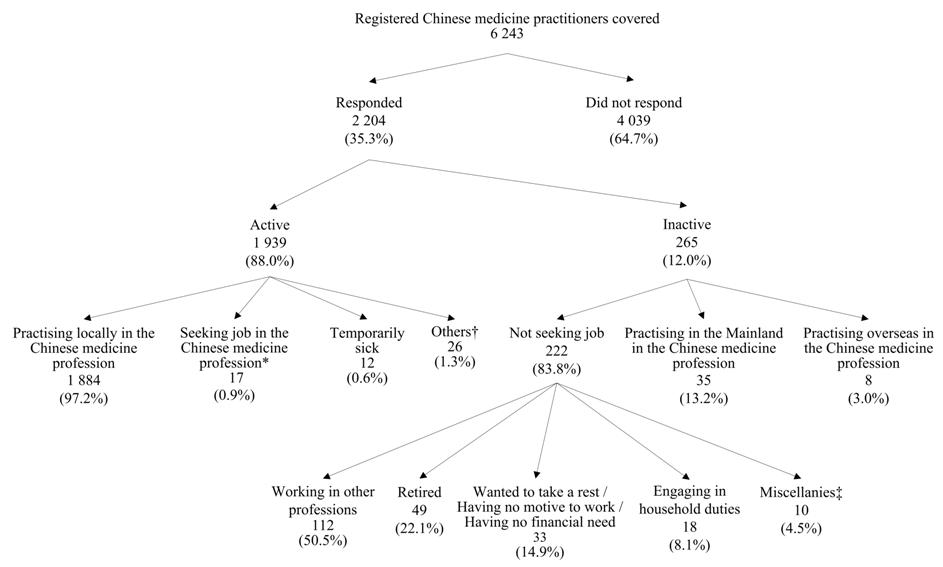
| Notes : | * | Figure refers to the number of responding registered Chinese medicine practitioners who (a) were not practising in the Chinese medicine profession in Hong Kong during the survey period; (b) had been available for work during the seven days before the survey; and (c) had sought work in the Chinese medicine profession during the 30 days before the survey. |
| † | Figure refers to the number of responding registered Chinese medicine practitioners who (a) were not practising in the Chinese medicine profession in Hong Kong during the survey period; (b) had been available for work during the seven days before the survey; and (c) were waiting to take up a new job, starting business on a subsequent date, expecting to return to their original jobs or believed that work was not available in the local Chinese medicine profession during the 30 days before the survey. | |
| ‡ | Figure refers to the number of responding registered Chinese medicine practitioners who reported undertaking study, emigrated, etc. | |
| Percentages may not add up to 100% due to rounding. |
3.4 One active registered Chinese medicine practitioner did not indicate sex. Of the remaining 1 883 active registered Chinese medicine practitioners enumerated who were practising in the local Chinese medicine practitioners profession, 1 274 (67.7%) were male and 609 (32.3%) were female, giving an overall sex ratio (males per 100 females) of 209. Apart from nine registered Chinese medicine practitioners who did not indicate age, the median age of the remaining 1 875 active registered Chinese medicine practitioners enumerated was 58.0 years. The median age of the active female Chinese medicine practitioners enumerated was 52.5 years and that of their male counterparts was 60.0 years.
3.5 The responding active registered Chinese medicine practitioners were requested to indicate the characteristics of their main jobs*. Distribution by sector for the main job showed that 88.2% were working in the private sector, followed by the subvented sector (5.8%), the Government and academic sectors (2.8%) and the Hospital Authority (2.7%).
3.6 The median age of the active registered Chinese medicine practitioners enumerated was 59.0 years for those working in the private sector, followed by 43.0 years for those working in the Government and the academic sectors, 31.0 years for those working in the subvented sector and 28.0 years for those working in the Hospital Authority.
* Main jobs referred to the jobs in which the registered Chinese medicine practitioners had spent most of their working time.
3.7 Of the 1 884 active registered Chinese medicine practitioners enumerated, 70.1% spent most of their working time on general practice, followed by 14.2% on bone-setting and 11.3% on acupuncture.
3.8 The median number of hours of work (excluding meal breaks) per week of the 1 884 active registered Chinese medicine practitioners enumerated was 44.0 hours. Among them, 243 (12.9%) registered Chinese medicine practitioners were required to undertake on-call duty, with a median of 10.0 hours of on-call duty (excluding normal duty) per week.
3.9 Of the 1 884 active registered Chinese medicine practitioners enumerated, 53.3% had passed the Licensing Examination (Section 61(1)(a) of the Chinese Medicine Ordinance) as their basic qualifications. Listed Chinese medicine practitioner who had been exempted from the Licensing Examination (Section 93 of the Chinese Medicine Ordinance) and who had passed the Registration Assessment (Section 94 of the Chinese Medicine Ordinance) accounted for 26.8% and 13.0% respectively.
3.10 Of the 1 884 active registered Chinese medicine practitioners enumerated, 990 (52.5%) received / were receiving additional training and 894 (47.5%) did not receive any additional training. Of the 990 active registered Chinese medicine practitioners with additional training, 48 (4.8%) had not yet completed the additional training, 280 (28.3%) held Certificates, 264 (26.7%) held Master’s Degrees, 190 (19.2%) held Bachelor’s Degrees and 128 (12.9%) held Diplomas as the highest qualification.
3.11 Among those registered Chinese medicine practitioners with additional training, some of them selected more than one field of additional training. The total number of count of active registered Chinese medicine practitioners who received / were receiving additional training was 2 556, in which 13.4% received / were receiving additional training in acupuncture and moxibustion of Chinese medicine, 12.2% in Chinese medicine (general practice), 8.2% in orthopaedics and traumatology of Chinese medicine and 7.3% in internal medicine of Chinese medicine.
3.12 Of the 990 registered Chinese medicine practitioners who received / were receiving additional training, 559 (56.5%) received / were receiving additional training in one field of additional training. Among them, 42.8% received / were receiving additional training in Chinese medicine (general practice), 20.9% in acupuncture and moxibustion of Chinese Medicine, 9.7% in orthopaedics and traumatology of Chinese medicine, 5.4% in integration of Chinese-Western medicine and 5.2% in internal medicine of Chinese medicine
(Chart B)
.
Chart B : Number of Field(s) of Additional Training Received / Being Received by Active Registered Chinese Medicine Practitioners Enumerated
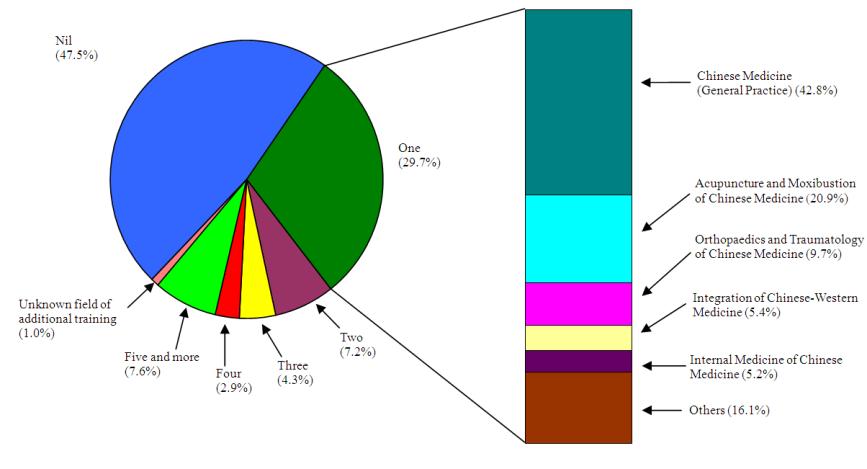
Total number of active registered Chinese medicine practitioners enumerated = 1 884
3.13 Regarding Continuing Education in Chinese Medicine (CME) activities, 1 789 (95.0%) of the active registered Chinese medicine practitioners reported that they had participated in CME activities in 2011, 79 (4.2%) did not participate in any CME activities and 16 (0.8%) did not report whether they had participated in CME activities or not. Among the 1 789 active registered Chinese medicine practitioners enumerated who had participated in CME activities, the distribution of CME points attained in the past 12 months was: 1 to 10 points (6.4%), 11 to 20 points (18.9%), 21 to 30 points (15.1%), 31 to 40 points (9.3%) and more than 40 points (50.3%).
IV. Chinese Medicine Practitioners with Limited Registration
4.1 Among the 26 responding Chinese medicine practitioners with limited registration, all were economically active (active)*† and practising in the local Chinese medicine profession as at 31.8.2011
(Chart C)
.
Chart C : Activity Status of Chinese Medicine Practitioners with Limited Registration Covered
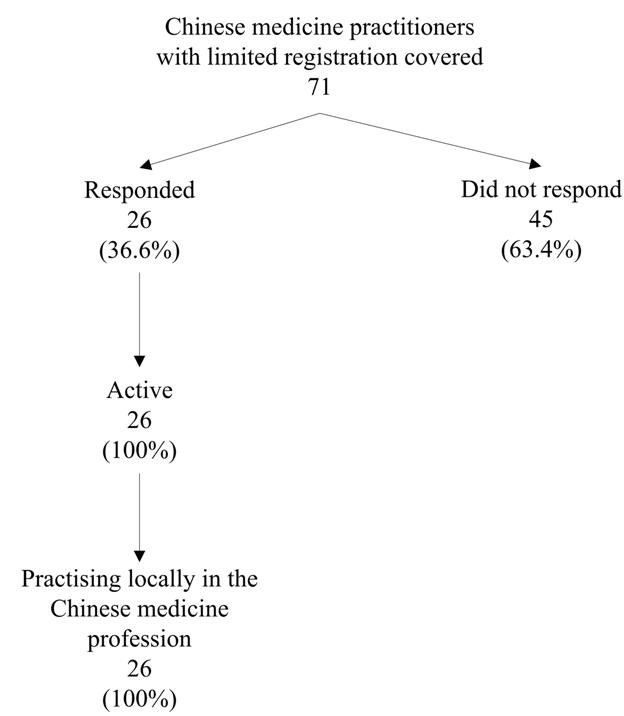
* In the survey, the criteria used in defining economically active / inactive followed those recommended by the International Labour Organization, which are also being used by the Census and Statistics Department in Hong Kong.
† “Economically active” Chinese medicine practitioners with limited registration comprised all “employed” and “unemployed” Chinese medicine practitioners with limited registration. “Employed” Chinese medicine practitioners with limited registration referred to those Chinese medicine practitioners with limited registration practising in the Chinese medicine profession in Hong Kong during the survey period, while “unemployed” Chinese medicine practitioners with limited registration referred to Chinese medicine practitioners with limited registration who (a) were not practising in the local Chinese medicine profession during the survey period; (b) had been available for work during the seven days before the survey; and (c) had sought work in the local Chinese medicine profession during the 30 days before the survey.
4.2 Of the 26 active Chinese medicine practitioners with limited registration enumerated who were practising in the local Chinese medicine profession, 14 (53.8%) were male and 12 (46.2%) were female, giving an overall sex ratio (males per 100 females) of 117. Apart from one Chinese medicine practitioner with limited registration who did not indicate age, the median age of the remaining 25 active Chinese medicine practitioners with limited registration enumerated was 53.0 years. The median age of the active female Chinese medicine practitioners with limited registration enumerated was 55.0 years and that of their male counterparts was 47.0 years.
4.3 The responding active Chinese medicine practitioners with limited registration were requested to indicate the characteristics of their main jobs*. Distribution by the sector for the main job showed that 61.5% of the active Chinese medicine practitioners with limited registration were working in the academic sector, followed by those working in the Hospital Authority (23.1%) and the subvented sector (15.4%).
4.4 The median age of the active Chinese medicine practitioners with limited registration enumerated was 54.0 years for those working in the Hospital Authority, followed by 53.0 years for those working in the academic sector and 50.5 years for those working in the subvented sector.
4.5 Of the 26 active Chinese medicine practitioners with limited registration enumerated, 57.7% spent most of their working time on general practice, followed by 26.9% on acupuncture.
4.6 The median number of hours of work (excluding meal breaks) per week of the 26 active Chinese medicine practitioners with limited registration enumerated was 40.0 hours. Among them, one (3.8%) Chinese medicine practitioner with limited registration was required to undertake on-call duty (excluding normal duty).
4.7 Of the 26 active Chinese medicine practitioners enumerated, 15 (57.7%) received / were receiving additional training and 11 (42.3%) did not receive any additional training. Of the 15 active Chinese medicine practitioners with limited registration with additional training, five (33.3%) held Doctoral Degrees and four (26.7%) held Bachelor’s Degrees as the highest qualification.
4.8 Among those Chinese medicine practitioners with limited registration with additional training, some of them selected more than one field of additional training. The total number of count of active Chinese medicine practitioners with limited registration who received / were receiving additional training was 42, in which 19.0% received / were receiving additional training in integration of Chinese-Western medicine, 9.5% in internal medicine of Chinese medicine and 7.1% in history of Chinese medicine & various theories of Chinese medicine / external medicine of Chinese medicine / gynaecology of Chinese medicine.
* Main jobs referred to the job in which the Chinese medicine practitioners with limited registration had spent most of their working time.
4.9 Of the 15 Chinese medicine practitioners with limited registration with additional training, four (26.7%) received / were receiving additional training in one field of additional training. Among them, 50.0% received / were receiving additional training in external medicine of Chinese medicine.
V. Listed Chinese Medicine Practitioners
5.1 Among the 564 responding listed Chinese medicine practitioners, 454 (80.5%) were economically active*† (active) in the local Chinese medicine profession as at 31.8.2011 and 110 (19.5%) were economically inactive*‡ (inactive) in the local Chinese medicine profession
(Chart D)
.
5.2 Of the 454 active listed Chinese medicine practitioners, seven were seeking jobs in the local Chinese medicine profession, three had not been available for work because of temporary sickness and five were waiting to take up a new job, expecting to return to their original jobs or believed that work was not available in the local Chinese medicine profession during the 30 days before the survey. The survey results presented in paragraph 5.4 below were based on the 439 responding active listed Chinese medicine practitioners who were practising in the local Chinese medicine profession as at 31.8.2011. As some information was missing from certain questionnaires, percentages presented below may not add up to 100%
(Chart D)
.
5.3 Among the 110 inactive listed Chinese medicine practitioners, 11 reported practising in the Mainland, eight reported practising overseas and 91 reported not seeking jobs in the local Chinese medicine profession during the 30 days before the survey. Among the 91 inactive listed Chinese medicine practitioners who reported not seeking jobs, the main reasons reported for not seeking jobs included: 37 (40.7%) were retired, 34 (37.4%) were working in other professions, nine (9.9%) were engaged in household duties and eight (8.8%) wanted to take a rest / had no motive to work / had no financial need, etc. (Chart D) .
* In the survey, the criteria used in defining economically active/inactive followed those recommended by the International Labour Organization, which are also being used by the Census and Statistics Department in Hong Kong.
† “Economically active” listed Chinese medicine practitioners comprised all “employed” and “unemployed” listed Chinese medicine practitioners. “Employed” listed Chinese medicine practitioners referred to those listed Chinese medicine practitioners practising in the Chinese medicine profession in Hong Kong during the survey period, while “unemployed” listed Chinese medicine practitioners referred to those listed Chinese medicine practitioners who (a) were not practising in the Chinese medicine profession during the survey period; (b) had been available for work during the seven days before the survey; and (c) had sought work in the Chinese medicine profession during the 30 days before the survey.
‡ “Economically inactive” listed Chinese medicine practitioners comprised listed Chinese medicine practitioners who were not practising in the Chinese medicine profession in Hong Kong during the survey period, excluding those who had been on leave during the survey period and who were “economically active” but “unemployed”.
Chart D : Activity Status of Listed Chinese Medicine Practitioners Covered
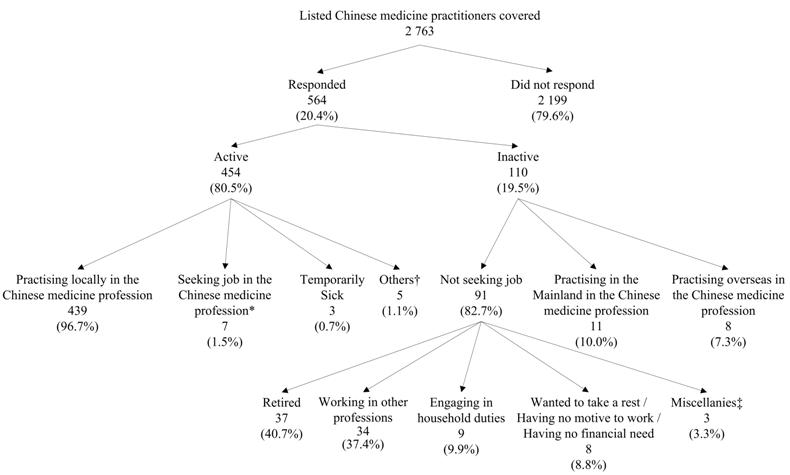
| Notes : | * | Figure refers to the number of responding listed Chinese medicine practitioners who (a) were not practising in the Chinese medicine profession in Hong Kong during the survey period; (b) had been available for work during the seven days before the survey; and (c) had sought work in the Chinese medicine profession during the 30 days before the survey. |
| † | Figure refers to the number of responding listed Chinese medicine practitioners who (a) were not practising in the Chinese medicine profession in Hong Kong during the survey period; (b) had been available for work during the seven days before the survey; and (c) were waiting to take up a new job, expecting to return to their original jobs or believed that work was not available in the local Chinese medicine profession during the 30 days before the survey. | |
| ‡ | Figure refers to the number of responding listed Chinese medicine practitioners who reported undertaking study, etc. | |
| Percentages may not add up to 100% due to rounding. |
5.4 One listed Chinese medicine practitioner did not indicate sex. Of the remaining 438 active listed Chinese medicine practitioners enumerated who were practising in the local Chinese medicine profession, 319 (72.8%) were male and 119 (27.2%) were female, giving an overall sex ratio (males per 100 females) of 268. The median age of the active listed Chinese medicine practitioners enumerated was 60.0 years. The median age of the active female listed Chinese medicine practitioners enumerated was 59.0 years and that of their male counterparts was 60.0 years.
5.5 The responding active listed Chinese medicine practitioners were requested to indicate the characteristics of their main jobs*. Distributed by sector for the main job showed that 95.2% of the active listed Chinese medicine practitioners enumerated were working in the private sector, followed by those working in the academic sector (0.9%) and the subvented sector (0.7%).
5.6 Of the 439 active listed Chinese medicine practitioners enumerated, 53.3% spent most of their working time on general practice, followed by 26.4% on bone-setting and 11.4% on acupuncture.
5.7 The median number of hours of work (excluding meal breaks) per week of the 439 active listed Chinese medicine practitioners enumerated was 42.0 hours. Among them, 65 (14.8%) were required to undertake on-call duty, with a median of 14.0 hours of on-call duty (excluding normal duty) per week.
* Main jobs referred to the job in which the listed Chinese medicine practitioners had spent most of their working time.
5.8 Of the 439 active listed Chinese medicine practitioners enumerated, 228 (51.9%) received / were receiving additional training and 211 (48.1%) did not receive any additional training. Of the 228 active listed Chinese medicine practitioners with additional training, 18 (7.9%) had not yet completed the additional training, 120 (52.6%) held Certificates, 47 (20.6%) held Diplomas and 29 (12.7%) held Bachelor’s Degrees as the highest qualification.
5.9 Among those listed Chinese medicine practitioners with additional training, some of them might select more than one field of additional training. The total number of count of active listed Chinese medicine practitioners enumerated was 694, in which 13.8% received additional training in Chinese medicine (general practice), 11.1% in acupuncture and moxibustion of Chinese medicine and 10.5% in orthopaedics and traumatology of Chinese medicine.
5.10 Of the 228 active listed Chinese medicine practitioners with additional training, 106 (46.5%) received / were receiving additional training in one field of additional training. Among them, 61.3% received / were receiving additional training in Chinese medicine (general practice), 15.1% in orthopaedics and traumatology of Chinese medicine, 10.4% in training programme attended before the Chinese medicine practitioners licensing examination and 5.7% in acupuncture and moxibustion of Chinese medicine
(Chart E)
.
|
Chart E : Number of Field(s) of Additional Training Received / Being Received by Active Listed Chinese Medicine Practitioners Enumerated |
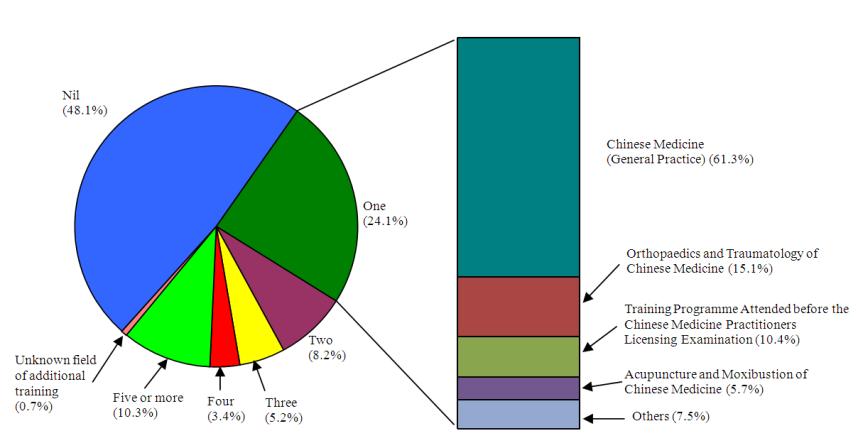
Total number of active listed Chinese medicine practitioners enumerated = 439
VI. Trend Analysis
6.1 The number of registered Chinese medicine practitioners covered increased from 5 012 in 2005 to 6 243 in 2011, while the number of Chinese medicine practitioners with limited registration covered also increased from 58 in 2005 to 71 in 2011. However, the number of listed Chinese medicine practitioners covered decreased from 2 988 in 2005 to 2 763 in 2011
(Chart F)
.
|
Chart F : Number of Chinese Medicine Practitioners Enumerated by Year (2005, 2008 and 2011) |
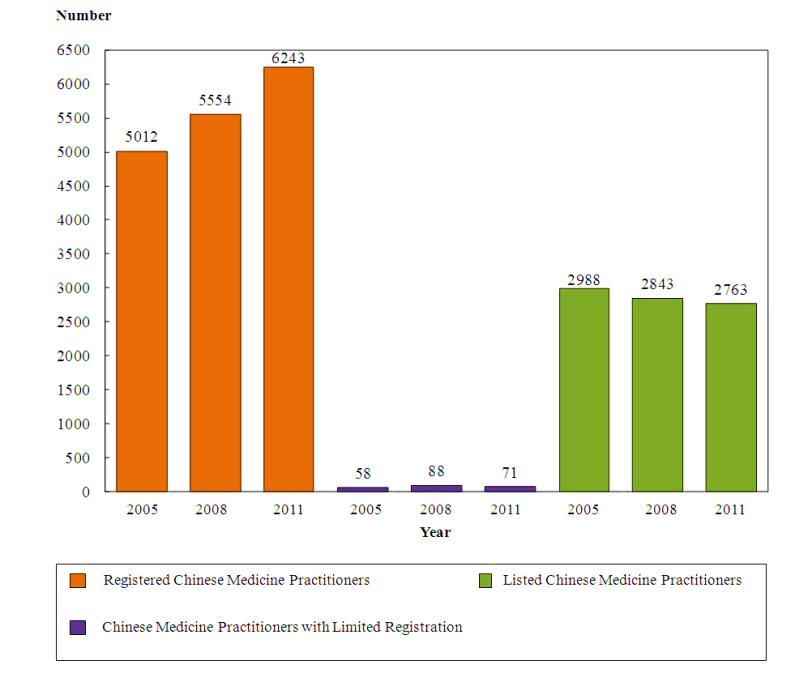
| Note: | Figures refer to Chinese medicine practitioners registered with the Chinese Medicine Council of Hong Kong or entered on the list of listed Chinese medicine practitioners maintained by the Chinese Medicine Council of Hong Kong under the Chinese Medicine Ordinance (Chapter 549) as at 31st August of the respective years. |
6.2 The median age of the active registered Chinese medicine practitioners enumerated remained largely stable (57.0 years in 2005 and 58.0 years in 2008 and 2011). The median age of the active Chinese medicine practitioners with limited registration enumerated varied between 52.0 years to 59.0 years, while the median age of the active listed Chinese medicine practitioners enumerated increased from 56.0 years to 60.0 years between 2005 and 2011
(Table A)
.
6.3 The sex ratio (males per 100 females) of active registered Chinese medicine practitioners enumerated decreased from 297 in 2005 to 209 in 2011. Similarly, the sex ratio (males per 100 females) of active Chinese medicine practitioners with limited registration enumerated decreased from 233 in 2005 to 117 in 2011, while the sex ratio (males per 100 females) of active listed Chinese medicine practitioners enumerated decreased from 384 in 2005 to 268 in 2011
(Table A)
.
6.4 From 2005 to 2011, the largest proportion of active registered Chinese medicine practitioners enumerated were working in the private sector, which employed about 90% of the registered Chinese medicine practitioners. A similar distribution was observed in listed Chinese medicine practitioners with more than 90% of the listed Chinese medicine practitioners working in the private sector during the same period. However, the proportion of active registered Chinese medicine practitioners who were working in the subvented sector increased from 2.3% in 2005 to 5.8% in 2011. The proportion of active Chinese medicine practitioners with limited registration enumerated working in the academic sector increased from 50.0% to 61.5% from 2005 to 2011, while that in the Hospital Authority increased from 20.0% to 23.1% and that in the subvented sector decreased from 30.0% to 15.4%
(Table A)
.
|
Table A : Selected Characteristics of Active Chinese Medicine Practitioners Enumerated (2005, 2008 and 2011) |
| Characteristics | Type of Chinese Medicine Practitioners | |||||||||||
| Registered Chinese Medicine Practitioners | Chinese Medicine Practitioners with Limited Registration | Listed Chinese Medicine Practitioners | ||||||||||
| 2005 | 2008 | 2011 | 2005 | 2008 | 2011 | 2005 | 2008 | 2011 | ||||
| A. | Chinese Medicine Practitioners Covered* |
5 012 |
5 554 |
6 243 |
58 |
88 |
71 |
2 988 |
2 843 |
2 763 |
||
| B. | Active Chinese Medicine Practitioners Enumerated |
|
|
|
|
|
|
|
|
|
||
| Number Enumerated |
1 935 |
2 927 |
1 884 |
20 |
37 |
26 |
600 |
805 |
439 |
|||
| Sex |
|
|
|
|
|
|
|
|
|
|||
| Male |
1 445 |
2 120 |
1 274 |
14 |
25 |
14 |
472 |
634 |
319 |
|||
| Female |
486 |
803 |
609 |
6 |
12 |
12 |
123 |
169 |
119 |
|||
| Unknown |
4 |
4 |
1 |
N.A. |
N.A. |
N.A. |
5 |
2 |
1 |
|||
| Sex Ratio (males per 100 females) |
297 |
264 |
209 |
233 |
208 |
117 |
384 |
375 |
268 |
|||
| Mean Age |
56.2 |
56.4 |
55.7 |
52.3 |
57.2 |
52.4 |
56.2 |
58.3 |
60.2 |
|||
| Median Age |
57.0 |
58.0 |
58.0 |
52.0 |
59.0 |
53.0 |
56.0 |
57.0 |
60.0 |
|||
| Sector for Work |
|
|
|
|
|
|
|
|
|
|||
| Government |
2 |
7 |
} |
N.A. |
N.A. |
N.A. |
N.A. |
N.A. |
N.A. |
|||
|
(0.1) |
(0.2) |
53 |
|
|
|
|
|
|
||||
| Academic |
46 |
84 |
(2.8) |
10 |
20 |
16 |
N.A. |
2 |
4 |
|||
|
(2.4) |
(2.9) |
(50.0) |
(54.1) |
(61.5) |
|
(0.2) |
(0.9) |
|||||
| Hospital Authority |
10 |
44 |
50 |
4 |
6 |
6 |
N.A. |
N.A. |
N.A. |
|||
|
(0.5) |
(1.5) |
(2.7) |
(20.0) |
(16.2) |
(23.1) |
|
|
|
||||
| Subvented |
45 |
89 |
109 |
6 |
11 |
4 |
4 |
5 |
3 |
|||
|
(2.3) |
(3.0) |
(5.8) |
(30.0) |
(29.7) |
(15.4) |
(0.7) |
(0.6) |
(0.7) |
||||
| Private |
1 793 |
2 663 |
1 661 |
N.A. |
N.A. |
N.A. |
568 |
782 |
418 |
|||
|
(92.7) |
(91.0) |
(88.2) |
|
|
|
(94.7) |
(97.1) |
(95.2) |
||||
| Unknown |
39 |
40 |
11 |
N.A. |
N.A. |
N.A. |
28 |
16 |
14 |
|||
|
(2.0) |
(1.4) |
(0.6) |
|
|
|
(4.7) |
(2.0) |
(3.2) |
||||
| Notes : | * | Figures refer to Chinese medicine practitioners registered with the Chinese Medicine Council of Hong Kong or entered on the list of listed Chinese medicine practitioners maintained by the Chinese Medicine Council of Hong Kong under the Chinese Medicine Ordinance (Chapter 549) as at 31st August of the respective years. |
| There may be slight discrepancy between the sum of individual items and the total due to rounding. | ||
| N.A. Not applicable |
VII. Limitations of Findings
7.1 The survey findings only represented the situation as at the survey reference date - 31.8.2011. Analysis on the characteristics of Chinese medicine practitioners performed was based on the data collected on those enumerated Chinese medicine practitioners only. As the characteristics of the non-responding Chinese medicine practitioners may be different from those who responded, the findings may not fully reflect the characteristics of all Chinese medicine practitioners practising in Hong Kong.
7.2 Since the number of Chinese medicine practitioners involved in some of the results was small, readers should interpret the relevant statistics with caution.
Department of Health
The Government of the Hong Kong
Special Administrative Region
November 2012